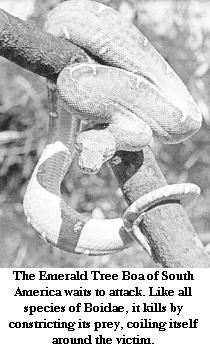



![]()
The Stranglers
The tropical zones are perfect for snakes, animals whose body-heat depends on the outside temperature. The Boidae, which includes the boa and the python, are widespread in the tropics and are all non-venomous. Some of these snakes, such as the Reticulate Python and the anaconda, grow to a considerable size, often over eight metres in length. All species of Boidae are able to swim but they move slowly on the ground because of their size and weight.
The larger species live on the ground in humid areas and have dark skins
which blend well with the undergrowth. Tree-living  boas
do not grow to more than two metres in length and their skins are coloured
different shades of green, keeping them camouflaged in the leaves and enabling
them to surprise their prey.
boas
do not grow to more than two metres in length and their skins are coloured
different shades of green, keeping them camouflaged in the leaves and enabling
them to surprise their prey.
Muscular strength is a characteristic common to the boas and pythons. They usually seize their prey with their jaws, coiling themselves round the victim and constricting it until it is suffocated. The prey, once dead, is swallowed whole. The snake then becomes rather torpid while it digests the prey. The capacity of the snake's stomach is proverbial and its capacity to swallow whole animals is made possible by its specially-shaped jaws which it is able to distend.
Snakes can live for a long time without food and some large species can fast for a whole year.
Poisonous Snakes
Probably less than one third of all species of snakes are venomous. Most of the more primitive snakes (boas and pythons) have solid teeth, wheras poisonous snakes have grooves down two teeth in the upper jaw: these are the poisonous fangs. The forked tongue which darts in and out of the mouth does not inject the poison but is mostly an organ for the snake to detect changes in its environment. The venom is injected from the poison gland via the fangs which are erected as the mouth is opened and the snake strikes at its prey. There are several species of snake-eating colubrids which attack poisonous snakes and appear to be immune to their venom.
The more dangerous poisonous snakes (whose venom will kill a man unless prompt treatment is given) occur in several families. While the scientific names of the family may not be familiar, the common names of the snakes are well-known. In the family Elapidae are the deadly cobras and mambas and the lesser known coralsnakes. The Crotalidae include the rattlesnakes, fer-de-lance and Pit Vipers of South-East Asia and the bushmaster of America. The latter, at 3.5 metres long, is the largest poisonous snake in Central and Souch America. The Viperidae include vipers and adders, the asp and several other species in Europe. True vipers are common in Africa and include the Horned Viper, Puff Adder and the equally deadly Gaboon Viper.
Return to Mirror Magazine contents
![]()
Please send your comments and suggestions on this web site to
info@suntimes.is.lk or to
webmaster@infolabs.is.lk